

Klako Group Webinars - January 2014. Sovereign Wealth Failure? Reuters Most scholars writing on sovereign wealth funds (SWFs) agree that countries create SWFs for one of three reasons.

The first reason is to hedge against commodity price volatility. Countries particularly dependent on the export of a certain natural resource tend to invoke this reason in creating SWFs. The second reason is to diversify away from cash holdings or low-yielding U.S. Treasury bills. Of course these goals are not mutually exclusive. Canada does not have this problem. What Leads a Country to Create a SWF? The existing SWF literature points to macroeconomic conditions common among SWF-having countries in order to identify drivers of SWF creation.
Some hope for reform from China’s Third Plenum. Author: Vikram Nehru, Carnegie Endowment China’s party leadership just announced the country’s reform agenda that will guide government policymaking and implementation for the next decade.
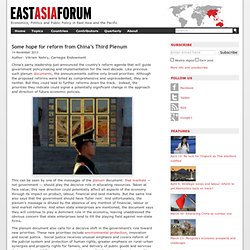
Like previous such plenum documents, the announcements outline only broad priorities. Although the proposed reforms were billed as comprehensive and unprecedented, they are neither. Facing up to change in China. Author: Dwight H.
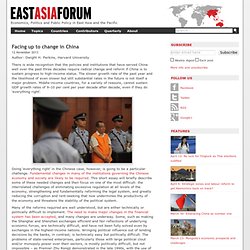
Perkins, Harvard University There is wide recognition that the policies and institutions that have served China well over the past three decades require radical change and reform if China is to sustain progress to high-income status. The slower growth rate of the past year and the likelihood of even slower but still substantial rates in the future is not itself a major problem. Middle-income countries, for a variety of reasons, cannot sustain GDP growth rates of 9–10 per cent per year decade after decade, even if they do ‘everything right’.
Doing ‘everything right’ in the Chinese case, however, is going to be a particular challenge. Many of the reforms required are well understood, but are either technically or politically difficult to implement. Sovereign Wealth Failure? Emerging-market multinationals: The rise of state capitalism. The Rise of Innovative State Capitalism. Over the past five years, as much of the developed world has staggered through crisis, a new type of capitalism has emerged as a challenger to laissez-faire economics.

Across much of the developing world, state capitalism—in which the state either owns companies or plays a major role in supporting or directing them—is replacing the free market. By 2015 state-owned wealth funds will control some $12 trillion in assets, far outpacing private investors. From 2004 through 2009, 120 state-owned companies made their debut on the Forbes list of the world’s largest corporations, while 250 private companies fell off it.
State companies now control about 90 percent of the world’s oil and large percentages of other resources—a far cry from the past, when BP (BP) and ExxonMobil (XOM) could dictate terms to the world. It is a mistake, however, to underestimate the innovative potential of state capitalism. Reality of China's Shanghai Free-Trade Zone suggests only a gentle pace of economic liberalisation. China's latest economic showpiece, the Shanghai Free-Trade Zone, opened for business on 29 September, amid much fanfare.
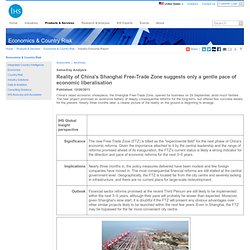
The new project promised an extensive battery of deeply consequential reforms for the long-term, but offered few concrete details for the present. Nearly three months later, a clearer picture of the reality on the ground is beginning to emerge. Sovereign wealth funds gain assets… Asian hedge funds enjoy positive September… Sovereign wealth funds globally have added more than USD750bn to their total assets since last year, according to research firm Preqin.

The growth, from USD4.62 trillion assets under management in 2012 to USD5.38 trillion in 2013, is largely down a number of new funds formed over the last few years, according to the firm, as well as capital injected into existing sovereign wealth funds. Preqin says Asia-based sovereign wealth funds have shown some of the largest growth in assets under management, with the assets of these sovereign wealth funds growing, on average, by 19 per cent since 2012. This is in comparison to the average 6 per cent growth in assets under management exhibited by Middle Eastern sovereign wealth funds.
In fact, Asia-based sovereign wealth funds account for a significant 47 per cent of global aggregate sovereign wealth fund assets, despite only representing 22 per cent of sovereign wealth funds globally by number. Sovereign wealth funds gain assets… Asian hedge funds enjoy positive September… The Future Global Reserve System - an Asian Perspective. Developing Asia's foreign exchange reserves have grown explosively since 1990.
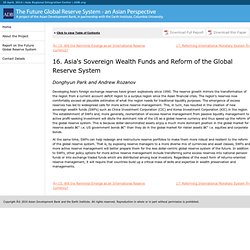
The reserve growth mirrors the transformation of the region from a current account deficit region to a surplus region since the Asian financial crisis. The region's reserves now comfortably exceed all plausible estimates of what the region needs for traditional liquidity purposes. The emergence of excess reserves has led to widespread calls for more active reserve management. Leviathans Double Bottom LineShannon Murphy.pdf.
Tufts Fletcher School. The Fletcher Network for Sovereign Wealth and Global Capital SovereigNET is a unique interdisciplinary network at Tufts University's Fletcher School dedicated to the study of sovereign wealth management and its impact on global capital markets.
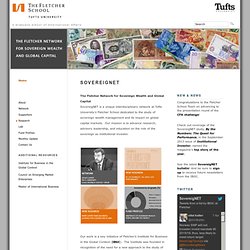
Our mission is to advance research, advisory leadership, and education on the role of the sovereign as institutional investor. Chinese Capitalism? China opens its first Free Trade Zone in Shanghai. Home » AIM Newswire » Chinese Capitalism?
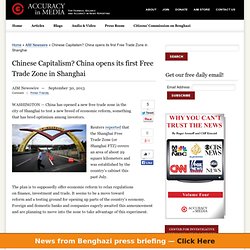
China opens its first Free Trade Zone in Shanghai Chinese Capitalism? China opens its first Free Trade Zone in Shanghai AIM Newswire — September 30, 2013 Comment | Printer Friendly WASHINGTON — China has opened a new free trade zone in the city of Shanghai to test a new breed of economic reform, something that has bred optimism among investors. Kerala, a role model in palliative care: Desiraju. The Rs.636 crore-National Programme on Palliative Care will have lots to learn from Kerala’s model of palliative care, Union Health Secretary Keshav Desiraju has said.

The State’s system of care, with active participation of community volunteers, could hold lot of relevance for the rest of the country when the national programme would be rolled out, .Mr. Desiraju said, while on a visit to Kerala. But it may not be an easy road ahead, he added. Mr. Doubts Surround China's Free Trade Zone in Shanghai. Economists are questioning the benefits of China's new free trade zone in Shanghai, despite rave reviews from the official press. On Sept. 27, the government outlined plans for the pilot free trade zone (FTZ), covering nearly 29 square kilometers (11 square miles) in the Shanghai area. Over the next three days, the official Xinhua news agency's English-language website posted no fewer than 14 stories, marking the opening of the FTZ on Sept. 29. Hailed as "the brainchild of Premier Li Keqiang" by state-run China Daily, the FTZ would serve as a laboratory for liberalizing the national economy, experimenting with eased trade, investment and monetary rules.
Xinhua cited "global observers" as calling the FTZ "the country's most significant reform push since the creation of the Shenzhen Special Economic Zone more than three decades ago. " Foreign commentary was more cautious and qualified. Shanghai's new free trade zone opens. It has been praised by analysts as the boldest policy experiment in decades; a step profoundly different from virtually everything the leadership in Beijing has done in commercial policies and deregulation in the past ten years.
Operations at the new China (Shanghai) Pilot Free Trade Zone (FTZ) started on Sunday, September 29, as the world's second-largest economy looks for new ways of reducing government intervention and opening itself more widely to foreign trade and investment, according to state media. Located in the outskirts of Shanghai, the nearly 29-square-kilometer (11-square-mile) FTZ covers four existing 'bonded zones' in the eastern Chinese megacity, including the Waigaoqiao Free Trade Zone, Waigaoqiao Free Trade Logistics Park, Yangshan Free Trade Port Area and the Pudong Airport Comprehensive Free Trade Zone.
A 'hotbed' for change. Pilot free trade zone in Shanghai to build open economy. Author: Bo Chen, Shanghai University of Finance and Economics The decision to establish a pilot free trade zone (FTZ) in Shanghai stems from a number of internal and external problems that China now faces. China still feeling for stones in new free trade zone. Author: Sacha Cody, ANU To ‘cross the river by feeling for stones’ is a well-known Chinese idiom, but through overuse it has lost its bite. This is a shame, as the idiom continues to have piercing relevance in understanding reform in China today. Don’t Like Asian State Capitalism? Blame the West. State capitalism, according to Bloomberg Businessweek, is a serious rival to U.S. and European businesses, which face being excluded from some markets.
“Instead of trying to prevent -- or worse, dismiss altogether -- the rise of state-capitalist systems,” the magazine argues, “U.S. and European companies and governments would do better to learn from them.” A similar case was made in the 1980s, when Japan’s state-supported conglomerates briefly threatened to take over the world. A Dying Model: Chinese Capitalism. China’s impressive growth is based on cheap labor, high levels of investment, and Western exports. The Rise of China and the Demise of the Capitalist World Economy: Minqi Li: 9781583671825: Amazon.com. Microsoft Word - Paper 7:The ‘Authoritarian’ Pull of Authoritarian State Capitalism .docx - paper7.pdf. China's Development a 'Threat' to Democracies, Authors Say. BEIJING — When China’s Foreign Ministry spokesman, Hong Lei, told the United States late on Saturday that it should “correctly treat China’s development,” what did he mean?
Indonesia Becomes Home to APEC's Public Private Partnership Pilot Project. Pilot Public-Private Partnership Centre in Indonesia. Quality infrastructure is critical to improving living standards and reducing poverty, through enabling access to markets and ensuring access to reliable sources of clean water, electricity, and other services. Asian economies will require an estimated US$8 trillion in infrastructure investment between 2010 and 2020. In order to facilitate greater private investment in infrastructure in Indonesia, Prime Minister Stephen Harper announced on October 8, 2013, that the Government of Canada will provide $5 million over five years for a pilot Public-Private Partnership (PPP) Centre in Indonesia. With support from Canada, Australia, Indonesia, the Asian Development Bank, and other partners, this pilot PPP Centre will help the Government of Indonesia identify a conduit of investment ready infrastructure projects within the country, and help them overcome the challenges with domestic coordination on a project-by-project basis.
ISEAS-Perspective-2013-27-Addressing-Infrastructure-Financing-in-Asia.pdf. Infrastructure for a Seamless Asia - 2009.08.31.book.infrastructure.seamless.asia.pdf. Centre-India Inc to roll out 2,500 model schools. Corporate India and the central government on Saturday sealed a pact to start 2,500 model schools across the country in public private partnership (PPP) mode, giving a decisive push to a six-year-old plan to change the face of secondary education. “The first set of schools under this new model would start from academic year 2015-16,” human resource development minister MM Pallam Raju said after a meeting with stakeholders and Planning Commission officials in New Delhi. Planning Commission deputy chairperson Montek Singh Ahluwalia said the agreement for these schools — Rashtriya Adarsh Vidyalayas — would be approved by an inter-ministerial panel on July 31.
Trusts, societies or not for profit entities set up by private companies will build and manage these senior secondary schools, one each in 2,500 blocks, that would serve as a benchmark of excellence for other schools. Indonesia Becomes Home to APEC's Public Private Partnership Pilot Project. Frugal innovation: From East to West and back again. By: Elizabeth SegranMonday, 15 April 2013 17:57 | Growing up in Pondicherry in South India, Navi Radjou observed that Asians have an in-built creativity when it comes to conserving resources. "Not only in India," he told Think Business from his office in Palo Alto, California, "but throughout Asia, people instinctively avoid wasting resources.
Street vendors reuse yesterday's newspaper to package up snacks. Frugal Innovation: A New Business Paradigm. GUEST COMMENTARY: What do Renault-Nissan, Siemens, and Unilever have in common? They are all pioneers of a groundbreaking business strategy called frugal innovation. India Inc to build model schools: Ambani, Tata and Mittal back government plan for public-private partnership. China's State Enterprises Have to Pay Up. The Chinese are experts at letting important news slip out quietly. China's State Enterprises Have to Pay Up. The Rise of Innovative State Capitalism. Doubts Surround China's Free Trade Zone in Shanghai. Shanghai's new free trade zone opens. Pilot free trade zone in Shanghai to build open economy. China still feeling for stones in new free trade zone. Emerging-market multinationals: The rise of state capitalism.